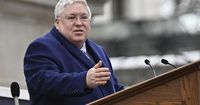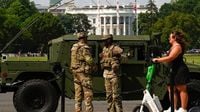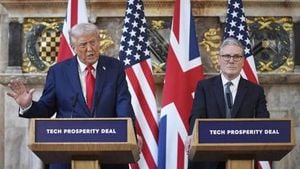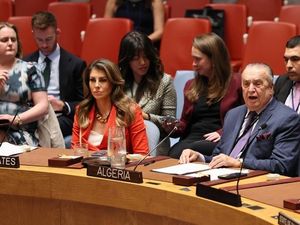On August 16, 2025, the streets of Washington, D.C. looked markedly different. National Guard vehicles rumbled past the Lincoln Memorial, and uniformed troops patrolled iconic landmarks like the National Mall and Union Station. The reason? A sweeping federal initiative, spearheaded by President Donald Trump, to overhaul policing in the nation’s capital through a massive deployment of National Guard troops and federal law enforcement officers—a move that has ignited fierce debate and drawn both applause and protest.
According to multiple reports, including Task & Purpose and the Los Angeles Times, three Republican-led states—West Virginia, South Carolina, and Ohio—announced on Saturday that they would send hundreds of their National Guard members to Washington. West Virginia Governor Patrick Morrisey stated his state would deploy between 300 and 400 troops, a number echoed in a press release and confirmed by the Joint Task Force – District of Columbia. South Carolina Governor Henry McMaster authorized 200 Guardsmen, noting they could be recalled in the event of a hurricane or other disaster. Ohio Governor Mike DeWine sent 150 military police, set to arrive in the coming days. Combined with the 826 District of Columbia National Guard members already activated, the total troop presence for the D.C. mission now exceeds 1,500.
President Trump’s executive order, issued earlier in the week, federalized local police forces and activated about 800 D.C. National Guard members. The administration’s stated goal: to crack down on crime and homelessness, which Trump described as an emergency threatening the federal government’s ability to operate efficiently. “At the request of the Trump administration, I have directed the @WVNationalGuard to support the President’s initiative to make D.C. safe and beautiful,” Governor Morrisey posted on X, adding, “The men and women of our National Guard represent the best of our state, and this mission reflects our shared commitment to a strong and secure America.”
Yet, the justification for this unprecedented show of force has come under scrutiny. Both the Justice Department and the Metropolitan Police Department (MPD) released statistics showing that crime in Washington, D.C. is at a 30-year low. As Straight Arrow News reported, State Representative Mike Pushkin, chair of the West Virginia Democratic Party, argued, “Let’s be honest—this deployment has nothing to do with public safety and everything to do with Donald Trump staging a stunt for his base.” Pushkin pointed out that the murder rate was higher in Trump’s last year in office and called the current deployment “pure political theater—a smokescreen to distract from Trump’s broken promise to release the Epstein files.”
Despite the controversy, the National Guard’s role remains largely supportive. Pentagon officials, quoted by Task & Purpose, clarified that Guardsmen “will not be arresting people, but they may temporarily limit the movement of an individual who has entered a restricted or secured area without permission” before turning them over to law enforcement. The focus is on presence patrols, crowd control, and protecting federal assets. The White House told CNN, “The National Guard will protect federal assets, create a safe environment for law enforcement officials to carry out their duties when required, and provide a visible presence to deter crime.”
Federal law enforcement personnel have also surged into the city. President Trump announced that he had “surged 500 federal agents into the district, including from the FBI, ATF, DEA, Park Police, the U.S. Marshals Service, the Secret Service, and the Department of Homeland Security.” According to an internal Secret Service memo obtained by CNN, more than 700 federal law enforcement personnel are supporting the effort daily, with that number expected to increase as more National Guard troops arrive.
For D.C. residents and city officials, the federal intervention has been deeply unsettling. On Tuesday, Mayor Muriel Bowser described the National Guard’s presence as “an intrusion on our autonomy.” In a letter to city residents, Bowser wrote, “Our limited self-government has never faced the type of test we are facing right now. If Washington residents stick together, we will show the entire nation what it looks like to fight for American democracy—even when we don’t have full access to it.” MPD Chief Pamela Smith, while expressing willingness to cooperate with federal troops, criticized the decision to send them, emphasizing the need to get illegal guns off the streets but questioning the necessity of such a large federal presence.
The response from the public has been equally passionate. On August 16, a protest at Dupont Circle drew scores of demonstrators before they marched 1.5 miles to the White House. Protesters carried banners reading “No fascist takeover of D.C.” and signs declaring “No military occupation.” Morgan Taylor, one of the protest organizers, told the American Press, “It’s hot, but I’m glad to be here. It’s good to see all these people out here. I can’t believe that this is happening in this country at this time.” John Finnigan, a long-time D.C. resident, called Trump’s moves “ridiculous because crime is down,” while Jamie Dickstein, a local teacher, said she felt “very uncomfortable and worried” for her students’ safety given the “unmarked officers of all types” now roaming the city.
Local leaders have found themselves in a bind. While obliged under federal law to cooperate with Trump’s order, they have bristled at the scope of the intervention. The administration even reversed course on an order to place the head of the Drug Enforcement Administration as an “emergency police commissioner” after the district’s top lawyer sued. In another move, Attorney General Pam Bondi issued a memo directing the MPD to cooperate with federal immigration enforcement, challenging the city’s status as a sanctuary city.
Meanwhile, the National Guard’s presence has not been without incident. On August 15, Guardsmen briefly detained a person who assaulted a Park Police officer during a patrol on the National Mall, as confirmed by a spokesperson for the Joint Task Force – District of Columbia to Task & Purpose. The individual was ultimately taken into custody by Park Police.
As the deployment continues, the city’s residents, leaders, and the nation at large are left grappling with the implications. Is this a necessary step to ensure public safety, or a dramatic overreach of federal power? The answer, for now, depends on whom you ask. But one thing is certain: Washington, D.C., finds itself at the center of a political and constitutional storm, with the eyes of the country—and the world—watching closely.





